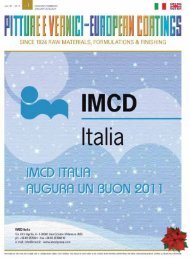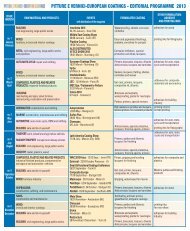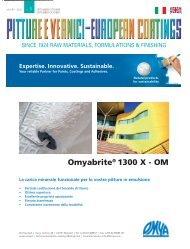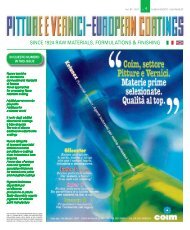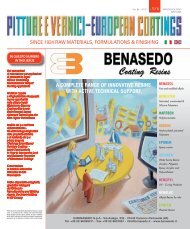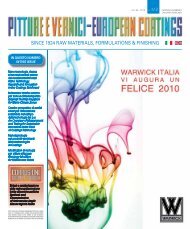Create successful ePaper yourself
Turn your PDF publications into a flip-book with our unique Google optimized e-Paper software.
La futura classificazione dei<br />
pericoli correlati agli essiccativi<br />
al cobalto è stata recentemente<br />
oggetto di accesi dibattiti.<br />
Ci si riferisce qui al bollettino informativo<br />
pubblicato da CEPE il<br />
10 novembre 2009 e agli ultimi<br />
aggiornamenti divulgati da<br />
OMG in cui si afferma che probabilmente,<br />
alla fine del <strong>2010</strong><br />
l’ottoato di cobalto e il cobalto<br />
nodecanoato saranno classificati<br />
come sostanze cancerogene<br />
di categoria 1B, il che signi -<br />
fica che queste sostanze in<br />
pre parazione a base di cobalto,<br />
in vendita al pubblico, devono<br />
limitarsi a concentrazioni inferiori<br />
allo 0,01%, una quantità<br />
troppo bassa per poter essere<br />
efficace. Questa notizia divulgata<br />
da CEPE e OMG non è corretta!<br />
In risposta a quanto affermato<br />
sopra, l’intento è chiarire le<br />
procedure normative e come<br />
queste possono avere un impatto<br />
sulle classificazioni dei<br />
pericoli. Ci si riferisce in particolare<br />
agli esempi del cobalto<br />
bis (2-etilesanoato), comunemente<br />
noto con il nome di cobalto<br />
ottoato (CAS 136-52-7; EI-<br />
NECS 205-250-6) e di cobalto<br />
nodecanoato (CAS 27253-31-2;<br />
EINECS 248-373-0).<br />
È molto probabile che il cobalto<br />
ottoato e il cobalto neodecanoato,<br />
alla fine del <strong>2010</strong> non<br />
saranno classificati come sostanze<br />
cancerogene di categoria<br />
1B. I documenti di registrazione<br />
REACH sono in fase di<br />
elaborazione e saranno presentati<br />
entro e non oltre il<br />
1° giugno del 2013. Sono in corso<br />
le attività di ricerca sul cobalto<br />
ottoato, che aiuteranno a<br />
riconoscere le proprietà dannose.<br />
Di conseguenza, il termine<br />
ultimo di questa indagine<br />
sarà prorogato oltre il <strong>2010</strong>.<br />
La normativa CLP richiede una<br />
prima stesura della classificazione<br />
da presentare entro il 3<br />
gennaio 2011. Non è possibile<br />
anticipare i risultati delle ricerche<br />
in corso, ma è molto im-<br />
NOTIZIE NEWS<br />
UMICORE INFORMA: ESSICCATIVI AL COBALTO<br />
E CLASSIFICAZIONE DEI PERICOLI AD ESSI<br />
CORRELATI<br />
62<br />
Pitture e Vernici - European Coatings • 3-4 / <strong>2010</strong><br />
probabile che vengano fornite<br />
le prove della natura cancerogena<br />
del cobalto ottoato e del<br />
cobalto ne odecanoato, tali da<br />
essere classificati come sostanze<br />
di categoria 1B. Alcuni ritengono<br />
che la idrosolubilità del<br />
cobalto ottoato e del cobalto<br />
neodecanoato sia sufficiente a<br />
classificare queste sostanze<br />
nello stesso modo delle sostanze<br />
a base di cobalto inorganiche<br />
solubili in acqua, già<br />
classificate come cancerogene<br />
di Categoria 1B (ad esempio il<br />
cobalto solfato). Si vuole qui<br />
sottolineare che l’idrosolubilità<br />
è solo uno dei molteplici criteri<br />
che vengono presi in considerazione<br />
quando si applicano<br />
i criteri discriminanti fra le sostanze<br />
chimiche.<br />
A tal riguardo, ci si riferisce alle<br />
linee guida OECD per la creazione<br />
delle categorie delle sostanze<br />
chimiche e dei criteri<br />
(www.oecd.org). Anche il consorzio<br />
REACH Cobalt applica i<br />
principi di classificazione su<br />
base scientifica e deve essere<br />
pienamente accettato il principio<br />
in base a cui l’idrosolubilità<br />
non può essere sufficiente.<br />
In base a REACH i documenti<br />
registrati devono riferirsi a tutte<br />
le sostanze chimiche e il termine<br />
di registrazione dipende<br />
dalla fascia di tonnellaggio e/o<br />
dalla classificazione del pericolo.<br />
I documenti di registrazione<br />
per gli essiccativi al cobalto saran<br />
no predisposti dal Consorzio<br />
REACH Cobalt (www.cobalt -<br />
reachconsortium.org/GREEN).<br />
I file REACH conterranno una<br />
serie di dati relativi alle proprietà<br />
fisico-chimiche ed ecotossicologiche,<br />
come specificato<br />
dagli allegati in materia<br />
della normativa REACH. Inoltre<br />
i criteri di classificazione e le categorie<br />
di appartenenza delle<br />
sostanze chimiche sono applicati<br />
in modo scientificamente<br />
approvato. Questa precisazione<br />
darà luogo ad una classificazione<br />
adeguata del pericolo.<br />
Umicore crede fermamente che<br />
gli essiccativi a base di cobal-<br />
to continueranno a giocare un<br />
ruolo chiave per le pitture a<br />
base alchidica. Precedentemente,<br />
Umicore si era impegnato<br />
insieme a CDI, CoRC e il<br />
Driers Group a raccogliere tutti<br />
i possibili dati rilevanti e, attualmente,<br />
Umicore si dedica a<br />
nuovi lavori di ricerca per reperire<br />
un numero superiore di<br />
dati relativi alle caratteristiche<br />
di possibile pericolo degli<br />
essiccativi al cobalto esistenti,<br />
in particolare concentrandosi<br />
sui criteri finali di genotossicità<br />
e di possibile rischio cancerogeno.<br />
Si sarà dunque in grado<br />
di classificare le sostanze in<br />
base a criteri scientifici idonei.<br />
Dal momento che il dibattito nasce<br />
dal comunicato CEPE (alimentato<br />
dalle voci diffuse da<br />
OMG), Umicore ha proposto a<br />
CEPE di richiedere la cooperazione<br />
dei membri associati di<br />
CoRC per ottenere tutte le informazioni<br />
più aggiornate in<br />
materia. Allo stato attuale, si è<br />
in attesa dell’approvazione di<br />
CEPE. È evidente che il termine<br />
ultimo della notifica CLP precede<br />
la data di registrazione anticipata<br />
di REACH.<br />
Il punto di vista di Umicore è<br />
che, con un alto indice di probabilità,<br />
il cobalto ottoato e il<br />
cobalto neodecanoato non saranno<br />
classificati come sostanze<br />
cancerogene di Categoria<br />
1B, entro il termine di notifica<br />
CLP fissata per il 3 gennaio<br />
2011. Questo dibattito potrebbe<br />
indurre i membri di CEPE<br />
ed altri produttori di pitture e inchiostri<br />
a trarre delle conclusioni<br />
errate, suscitando dubbi e<br />
confusione nel mercato, da cui<br />
deriverebbero ulteriori sforzi<br />
superflui e lavoro di R&D da<br />
parte dei produttori di materie<br />
prime per smentire opinioni<br />
fuorvianti.<br />
Si tratta di una situazione che<br />
si vuole assolutamente evitare.<br />
Si auspica che questo comunicato<br />
si riveli infine utile per capire<br />
le attività di classificazioni<br />
future riferite agli essiccativi<br />
a base di cobalto.<br />
UMICORE INFORMS: COBALT<br />
DRIERS AND THEIR HAZARD<br />
CLASSIFICATION<br />
The future hazard classification of cobalt driers has recently been<br />
subject to much debate. We refer to the information bulletin released<br />
by CEPE on 10 November 2009 and to the information spread<br />
by OMG stating that it is probable that cobalt octoate and cobalt<br />
neodecanoate will be classified as Category 1B carcinogens at the<br />
end of <strong>2010</strong>, which would mean that the use of these cobalt substances<br />
in preparations sold to the public is limited to concentrations<br />
smaller than 0.01% which is too low to be effective. This information,<br />
released by CEPE and OMG, is incorrect!<br />
In response we wish to clarify ongoing regulatory processes and<br />
how these may impact hazard classifications. We refer in particu -<br />
lar to the examples of cobalt bis (2-ethylhexanoate), commonly<br />
known as cobalt octoate (CAS 136-52-7; EINECS 205-250-6) and<br />
cobalt neodecanoate (CAS 27253-31-2; EINECS 248-373-0).<br />
It is highly probable that cobalt octoate and cobalt neodecanoate<br />
will not be classified as Category 1B carcinogens at the end of <strong>2010</strong>.<br />
The REACH registration file is being prepared and will be submitted<br />
the latest at 1 June 2013. There is ongoing research on cobalt octoate<br />
which will help to better understand the hazardous properties.<br />
As a result the timeline for this research goes way beyond<br />
<strong>2010</strong>. The CLP regulation requires a classification proposal to be<br />
submitted the latest by 3 January 2011. We cannot anticipate the<br />
results of ongoing research but it is very unlikely that evidence will<br />
be available to classify cobalt octoate and cobalt neodecanoate<br />
as Category 1B carcinogens. Some believe that the water solubility<br />
of cobalt octoate and cobalt neodecanoate is sufficient to classify<br />
these substances the same as inorganic water soluble cobalt substances<br />
which are already classified as Category 1B carcinogens (example<br />
cobalt sulphate). We want to stress that the water solubility<br />
is only one of many criteria that is considered when applying readacross<br />
between chemical substances. In this regard we refer to OECD<br />
guideline on grouping of chemicals substances and read-across<br />
(www.oecd.org). Also the cobalt REACH consortium is applying the<br />
read-across principles on a scientifically justified manner and it must<br />
be absolutely clear that water solubility alone is not sufficient.<br />
Under REACH registration files must be submitted for all chemical<br />
substances and the deadline for registration depends on the<br />
tonnage band and/or hazard classification. The registration files<br />
for cobalt driers will be prepared by the Cobalt REACH Consortium<br />
(www.cobaltreachconsortium.org/GREEN). The REACH file will contain<br />
a series of data on physicochemical and (eco)toxicological properties<br />
as specified by the relevant Annexes of the REACH regulation.<br />
Also read-across and grouping of chemical substances is applied in<br />
a scientifically justified way. This information will lead to appropriate<br />
hazard classifications. Umicore is convinced that cobalt based driers<br />
continue to play a key role in alkyd-based paints. Earlier, Umicore<br />
had engaged, together with the CDI, the CoRC and the Driers Group,<br />
in collecting all possible relevant data. Today Umicore has further engaged<br />
in additional research to collect more data about hazardous characteristics<br />
of existing cobalt driers and in particular addressing the<br />
important endpoints genotoxicity and carcinogenicity. We will then<br />
be able to classify the substances based on sound science.<br />
Because the entire debate has originated from the CEPE communiqué<br />
(empowered by the rumours spread by OMG), Umicore<br />
has proposed CEPE to apply for associate membership of the CoRC<br />
to enable CEPE to get all the information at first hand. Today we<br />
are awaiting the acceptance of CEPE. It is clear that the CLP notification<br />
deadline comes earlier than the anticipated REACH registration<br />
date. Umicore’s standpoint is that it is highly probable that<br />
cobalt octoate and cobalt neodecanoate will not be classified as<br />
Category 1B carcinogens by the CLP deadline of 3 January 2011.<br />
This debate may cause CEPE members and other paint and ink manufacturers<br />
to draw wrong conclusions resulting in doubt and confusion<br />
in the market. It can take a lot of additional and unnecessary<br />
efforts and R&D from raw material producers to invalidate<br />
these rumours. This is a situation we absolutely want to avoid.<br />
We hope this letter proves useful for your understanding of future<br />
hazard classifications of cobalt based driers.




